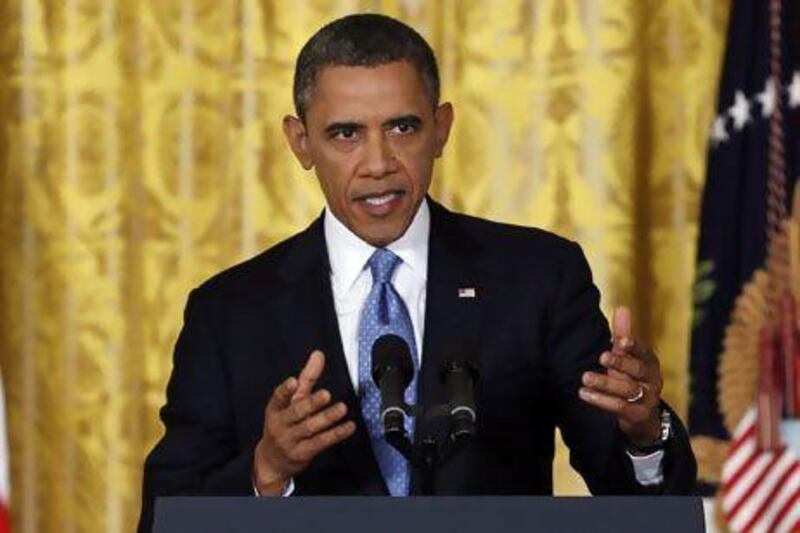As the United States heads toward its second phoney fiscal crisis in as many months, the president Barack Obama is persisting with his tough new line. The debt ceiling must be raised without preconditions, he says, and he isn't willing to discuss it.
In one way, he is right. The debt ceiling is an instrument of economic self-harm. It is ridiculous and should be scrapped. But Obama should be open to replacing it with something more intelligent.
Attacks on the debt ceiling, stupid as the rule may be, ought to be more discriminating.
It's a bad fiscal rule not because it obliges Congress to second-guess its own previous decisions (the standard critique), but because the particular kind of second-guessing it requires is so dumb and unproductive.
Most critics of the debt ceiling argue that it is an affront to simple logic. Congress votes each year on spending and taxes. (Actually it doesn't vote annually on most entitlement spending - that just happens automatically.)
Future borrowing and debt levels follow directly from those decisions. So the debt ceiling in effect obliges the government to disobey its own instructions. That is self-contradictory, critics say.
This is a lazy argument. In any system of checks and balances, there will be second-guessing. And a lot can be said for a fiscal rule that forces Congress to examine its tax and spending decisions more carefully - or forces it to undo previous choices if the outlook for deficits and debt looks unexpectedly bad.
This basic principle shouldn't be unfamiliar. Individual states are obliged to balance their current budgets. That might be good or bad policy, but it isn't self-contradictory.
In the rest of the world, many countries have adopted some form of fiscal rule to discipline their tax and spending choices - including caps on budget deficits (with or without adjustment for the business cycle) or on debt.
What is absurd is the particular form of America's debt-ceiling rule. The ceiling is set at a fixed dollar value, so it is certain to be breached at some point either because of inflation or economic growth.
Bear in mind, in a growing economy, a small budget deficit probably implies stable or falling debt as a ratio of GDP.
Fiscal policy as cautious and conservative as that will nonetheless breach a nominal-dollar debt ceiling. No plausible rationale exists for the American approach. Moreover, the threat of imminent default - the only sanction envisaged by the rule - is so extreme it is barely credible.
Everybody expects the debt ceiling to be raised in the end, as it always has been, so it imposes zero discipline when fiscal decisions are first being made. Taxes and spending are set as though the rule simply does not exist.
Yet once relations between the parties in Washington sink to a certain point, the rule can be used, like now, as a tool for reckless fiscal brinkmanship. It is the worst possible combination. The rule has no effect when it counts - and when a more sensibly designed restraint might be useful. Later, it becomes a doomsday machine.
Some of its defenders argue that, messy and dangerous as the process may be, the occasional threat of crisis does at least apply some downwards pressure to borrowing.
At the very least, they say, it's a chance to lodge a complaint. As a senator, Mr Obama voted against raising the debt ceiling in protest at George W Bush's budgets.
These justifications aren't persuasive. Up to now, the rule simply has not worked as its defenders claim. True, the debt-ceiling impasse of 2011 gave rise to the fiscal cliff and its commitment to unduly severe fiscal contraction - but see what just happened. Congress reversed the commitment.
The debt-ceiling rule is a formula for getting nothing done at inordinate cost. It would be a bad way to make fiscal policy even if the recurring threat of default succeeded in getting spending and borrowing under control. So far, it hasn't.
At the moment, Republicans are more committed to the politics of protest and dysfunction than to cautious fiscal policy, but if that should ever change they might think about proposing a different fiscal rule - maybe even one that many Democrats could embrace.
Several variants are possible. One would cap growth in federal spending at the trend rate of growth of the economy. This would let spending rise during recessions and curb its expansion during booms, thus allowing scope for Keynesian countercyclical policy. However, this approach requires agreement on the normal level of spending, and that will not be easy to achieve.
A more elastic rule is the so-called debt brake, as used in Switzerland. This would tie growth in spending to growth in business-cycle-adjusted tax revenues.
Using this approach, structural spending can grow faster than the economy, but only if taxes are raised at the same time.
A debt brake would not directly limit the size of government, but it would restrain deficits and public debt. It would also force Washington to be more honest about the tax implications of higher spending and the spending implications of lower taxes.
Budget forecasting is an imprecise business, so second- guessing once the facts are in would still be needed, and policy would have to be adjusted on the fly.
However, the first requirement of any fiscal rule is that it guides budget deliberations from the start.
The second requirement is that its correction mechanism, discretionary or automatic, is moderate enough to be credible. Defaulting on public debt doesn't qualify.
Done right, the debt-brake approach passes these tests. The debt-ceiling rule by its very design fails both, and that's why it should be scrapped.
* Bloomberg News





